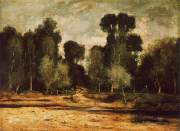

Realism, as opposed to momentary events and the fugitive nature of appearances, emphasised relevant elements of reality. Elements of an occasional character are avoided to stress relevant connections, and messages are condensed. Reality as seen is portrayed without details and with controlled brushwork in large units of landscapes while the essence is also present.
Realism, which still has a lot of followers, became wide-spread in the late 19th century. László Paál (Morning in the Forest, 1875; The Depth of the Forest, 1873), Mihály Munkácsy (Landscape with River, c. 1880; Park in Colpach, 1886), Pál Szinyei Merse (Thawing Snow, 1884-95), Géza Mészöly (End of Village, 1875), László Mednyánszky (View of Dunajec, c. 1893), Lajos Deák Ébner (Road of the Wood Mallows, 1880), Sándor Bihari and Adolf Fényes (Forenoon in a Provincial Town, 1904), all of the Nagybánya art school (e.g. Károly Ferenczy: Woodsmen Returning Home, 1899), and József Koszta (Before the Thunderstorm, 1909), Gyula Rudnay (Street at Nagybábony, c. 1921) and János Tornyai (Morning at Autumn, 1907), and some more artists, were influenced by realism at least during particular periods of their lives.